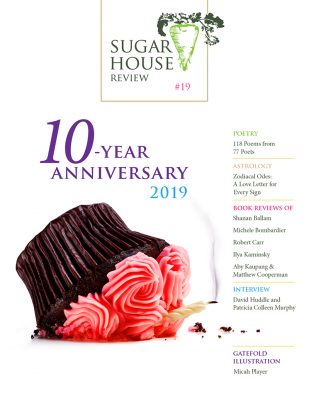Nothing Beets Poetry: Sugar House Review Celebrates 10 Years of Publication
Art
Once you’ve been a part of running a literary magazine, it’s easy to see how most independent journals don’t last very long,” says Natalie Young—Founding Editor and Graphic Designer for the local literary journal Sugar House Review—of the challenges she’s faced in running the publication. “It’s a labor of love and comes with frustrations we [the team] didn’t imagine.” However, this uphill battle has more than paid of for Sugar House. The journal’s upcoming issue (No.19) celebrates 10 years of publication, a milestone in and of itself for a literary journal, saying nothing of the praise, recognition and growth that Sugar House Review has garnered over their lifetime.
Young originally founded Sugar House Review with Nano Taggart, Jerry VanIeperen and John Kippen. “The four of us had been in a writing group together for a number of years, so we talked about poetry a lot—our own, other people’s, the craft, etc.” says Young. “One day, the idea of creating a journal came up, and we got excited about us being the ones to do it—partially because we thought it would be an exciting project and partially because, at the time, Utah didn’t have an independent poetry journal.” Young and Taggart are now the sole editors of the journal. They are also helped by Contributing Review Editor Michael McLane and “the best group of [volunteer] readers we’ve ever had,” says Young.
“One day, the idea of creating a journal came up, and we got excited about us being the ones to do it—partially because we thought it would be an exciting project and partially because, at the time, Utah didn’t have an independent poetry journal.”

While Sugar House Review is primarily focused on poetry and poetry-related content (as opposed to short stories, essays, etc.), there’s little else reining in the creative limits of the submissions. “Our eclectic style was apparent early one because there were four or five of us reading submissions,” says Young. “We all had different tastes but could appreciate good poetry no matter the style. We receive many more submissions now than we did before, so we have the luxury of receiving a higher caliber of poetry overall.” This increase in quantity and quality of content has earned Sugar House Review a reputation for greatness both in state and throughout the country. The journal has won multiple Pushcart Prizes and has recently been certified as a 501(c)(3) nonprofit organization.
The staff of Sugar House Review are all working writers themselves, and they find that their own practice also benefits from the heap of content that the journal works through for every issue. Young says, “My own writing has gotten much better from reading so much contemporary poetry.” Every young writer has inevitably been told that reading is the best thing you can do to hone your craft, and the editors and readers of Sugar House Review have firsthand verification: “When you read submissions for a journal, you get to see the good, the bad, the mediocre; it really shows you what is happening in the moment,” Young says. “It shines a light on what you want to strive for and stay away from.”
Sugar House Review has earned their 10 years and is rightfully celebrating this milestone with a special double issue and the release of their first standalone book.
Each issue of Sugar House Review features an array of national and international poets, but the publication has (and always will) retain a close connection with the Utah literary scene. “From the beginning, we wanted Sugar House Review to have live readings in the community, to support our contributors and give an additional poetry experience to our audience,” says Young. Throughout its history, the journal has hosted these readings throughout Utah, primarily in Young and Taggart’s now-residence of Cedar City. Further, the magazine’s logo is a line drawing of a sugar beet, a nod to the namesake root of their home neighborhood.
Against the ever-increasing digitization of print media, Sugar House Review remains a (mostly) print-only publication. “We’ve considered going online, because it would be more economical,” says Young, “but ultimately, I’d still rather hold a book in my hands and read it, rather than read it on a digital device. Having a tactile experience is something that can’t be replaced with online publishing.” Each issue of Sugar House Review is thus a physical artifact, one that immortalizes both the reading experience and the work of the published authors beyond the often nebulous garbage heap of the digital cloud.
“From the beginning, we wanted Sugar House Review to have live readings in the community, to support our contributors and give an additional poetry experience to our audience.”
Against the challenges inherent in running a journal, through geographical moves and staff changes, after unprecedented growth and expansion; Sugar House Review has earned their 10 years and is rightfully celebrating this milestone with a special double issue and the release of their first standalone book. “It will be a short book—or as literary people call it, a chapbook—by David Lee, Utah’s first Poet Laureate,” says Young. To commemorate the release of Lee’s book, Sugar House will host a reading of Lee’s The Allegory of Perfection with the author in the spring of 2020, date to be determined.
All 18 issues of Sugar House Review are available for purchase at sugarhousereview.com, and keep an eye out for the upcoming 10-year anniversary issue and book launch event. Writers can submit their work at sugarhousereview.com/submit, and if you’re interested in volunteering or otherwise becoming involved with the journal, contact editors@sugarhousereview.com.
More on SLUGMag.com:
Sound, Symbolism & Meter: Utah Poetry—Rock Canyon Poets
Salt Lake Poetry Slam Finals: It’s Now or Never
![“It’s a labor of love and comes with frustrations we [the team] didn’t imagine,” says Natalie Young on creating and running Sugar House Review](https://dev.slugmag.com/wp/wp-content/uploads/2019/11/Ed-372-Sugar-House-Review-Natalie-Young.jpg)

